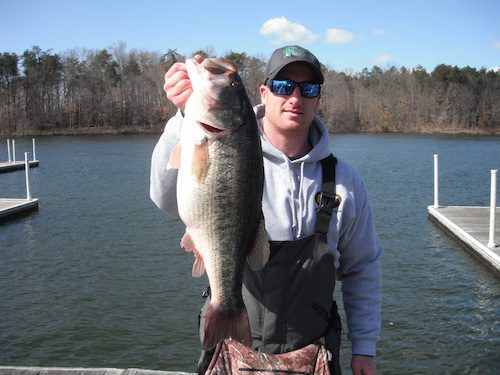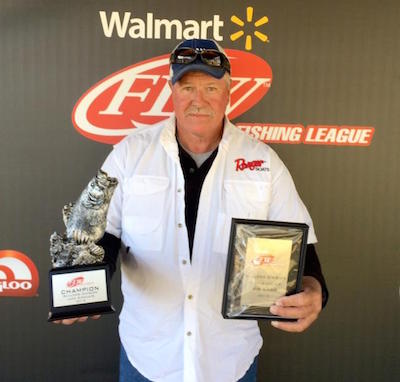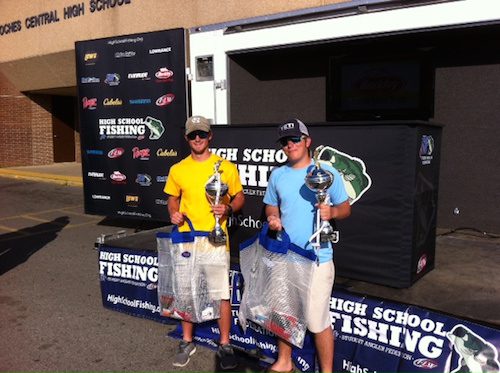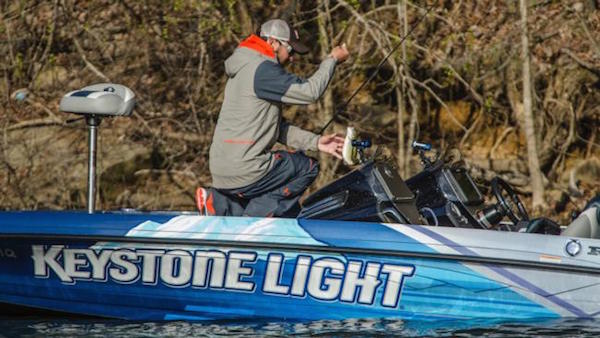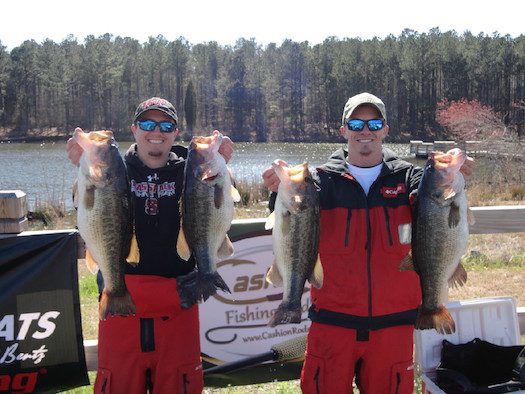FLW COLLEGE FISHING CENTRAL CONFERENCE SET TO OPEN ON TABLE ROCK LAKE
[print_link]
KIMBERLING CITY, Mo. (March. 31, 2015) –
FLW College Fishing is headed to
Table Rock Lake April 11 for the first of three regular-season stops in the Central Conference. A full field of college teams will be competing for a top award of $2,000 and a berth in the Central Conference Championship tournament.
“It should be a great tournament for these anglers,” said
Walmart FLW Tour pro Stacey King, of Reed Springs, Missouri. “With the rain we’ve had these past couple of weeks, there will be a lot of options for catching fish. If competitors want to fish the shallow, off-color water they’ll find bass in the rivers and feeder creeks. The main lake is still fairly clear, so if they prefer fishing a little deeper, they’ll find success there as well.
“The fish are moving shallow in both the rivers and main lake, but there still may be some suspended fish out in the main-lake timber that haven’t moved in yet. Most bass are in the prespawn phase, but there may be some fish spawning by tournament time.
“As for baits, anglers will probably reach for swimbaits, grubs, jerkbaits and look to attract fish in the main lake area,” King continued. “There is potential for a topwater bite depending on how warm it gets between now and the tournament. In the rivers and creeks, they’ll catch them on crankbaits, spinnerbaits and chatterbaits because of the murkier water. Pitching jigs will also be a dominant pattern. There’s going to be a lot of ways to catch fish out there.”
King went on to say that if the water temperature rises before tournament time, the fish could be very active.
“Right now the temperature is in the mid-50s, but with another five to 10 degrees I could see some big ones coming in,” King said. “With all of the options out there, the winners could be bringing in over 20 pounds of fish.”
Anglers will take off from the Kimberling Marina & Resort located at 72 Marina Way in Kimberling City at 6:30 a.m. CDT Saturday. Weigh-in will be held at the marina beginning at 2:30 p.m. Takeoff and weigh-in are free and open to the public.
Schools competing in the Table Rock Lake tournament, which is hosted by Table Rock Lake Chamber of Commerce, include:
Ball State University – Rhett Braun, Parker City, Ind., and Brian James, Muncie, Ind.
Eastern Illinois University – Mitchell Meinhart, Effingham, Ill., and Evan Hakman, Mason, Ill.
Eastern Illinois University – Dan Martin, Elmhurst, Ill., and Phillip Arnold, Pana, Ill.
Eastern Kentucky University – Ethan Snyder, Flaherty, Ky., and Shaw Owens, Barboursville, Ky.
Greenville College – Ray Hingson, Montrose, Ill., and David Weyers, Peora, Ill.
Illinois Central College – Justin Schick, Morton, Ill., and Tyler Rocke, Peoria, Ill.
Illinois State University – Bryce Wegman and Carlos Thomas, both of Normal, Ill.
Indiana Business College – Jordan Nauert, Fillmore, Ind., and Brody Comer, Terre Haute, Ind.
Indiana State University – Blaine Timonera, Batesville, Ind., and Andrew Feutz, Eminence, Ind.
Indiana State University – Zac Niehaus, Brazil, Ind., and Jeremy Crocker, Lowell, Ind.
Indiana State University – Nicholas Gallina, Griffith, Ind., and Tyler Wilson, Brazil, Ind.
Iowa State University – Dustin Kroening, McHenry, Ill., and McKinley Geiger, Lombard , Ill.
Iowa State University – Andrew Paulsen, Ames, Iowa, and Justin Heim, Luxemburg, Iowa
Iowa State University – Pat Morrison, Omaha, Neb., and Jake Olson, West Des Moines, Iowa
Iowa State University – Shane Boeshart, Clear Lake, Iowa, and Tanner Hamelau, Legrand, Iowa
Iowa State University – Zachary Hartley, Minneapolis, Minn., and Zac Beek, Bloomington, Minn.
Kansas State University – Garrett Cates, Overland Park, Kan., and Brett Herder, Lee’s Summit, Mo.
Kansas State University – Kyle Alsop, Overland Park, Kan., and Taylor Bivins, Manhattan, Kan.
McKendree University – Brock Wilke and Curtis Lilly, both of Saint Rose, Ill.
McKendree University – Austin Chapman, Blue Mound, Ill., and Phillip Germagliotti, Highland, Ill.
McKendree University – Dustin Pendegraft and Shane Campbell, both of Summerfield, Ill.
McKendree University – Jordan Ledbetter and Trent Robinson, both of Carlyle, Ill.
Milwaukee School of Engineering – Charles Nalbach, Neenah, Wis, and Kevin Gross, Wheeling, Ill.
Missouri State University – Darin Schildknecht, Springfield, Mo., and Brian Bueker, Kansas City, Mo.
Missouri State University – Cody Hamacher and Hayden Lee, both of Jefferson City, Mo.
Missouri State University – Crosley Welch, Branson, Mo., and Brandon Duemmel, Jefferson City, Mo.
Missouri State University – Kyle Doherty, Chesterfield, Mo., and Nick King, Oakville, Mo.
Missouri State University – Tyler Ellis, Springfield, Mo., and Matt Fielder, High Ridge, Mo.
Northern Illinois University – Jason Bowen, Vernon Hills, Ill., and Justin Garza, Joliet, Ill.
Northern Illinois University – Quinn Groenwald, DeKalb, Ill., and Ryan Moser, Elgin, Ill.
Northwest Missouri State University – Adam Almohtadi, Blue Springs, Mo., and Andrew Nordbye, Saint Joseph, Mo.
Purdue University-Fort Wayne – Parker Watts and Joseph Sittler, both of Fort Wayne, Ind.
Saint Cloud State University – Brandon Donovan, White Bear Lake, Minn., and Daniel Carlson, Milaca, Minn.
Saint Cloud State University – Tyler Gromberg, Saint Cloud, Minn. and Alex Almich, Buffalo Lake, Minn.
Southern Illinois University – Kyle Wagner, Waterloo, Ill., and Matt Stevens, Belleville, Ill.
South Dakota State University – Kaiden Karst, Pierre, S.D., and Chase Porter, Sioux Falls, S.D.
Saint Ambrose University – Cole Atkinson and Aaron Reynolds, both of Camanche, Iowa
Transylvania University – Nicholas Conway, Flemingsburg, Ky., and Emil Jake, Madisonville, Ky.
University of Central Missouri – Layne Woods, Hollister, Mo., and Corey Vance, Minneola, Minn.
University of Illinois – Charlie Sterrett, Naperville, Ill., and Bret Vogt, Barrington, Ill.
University of Illinois – Qiurun Chen and Luke Stoner, both of Pekin, Ill.
University of Iowa – Collin Cook and Keaton Williams, both of Fort Dodge, Iowa
University of Minnesota – Chris Burgan, Rhinelander, Wis., and Trevor Lo, Woodbury, Minn.
University of Minnesota-Duluth – Mark Shirley, Saint Cloud, Minn., and James Chapman, South Haven, Minn.
University of Nebraska – Ben Kroeger and Kyle Branecki, both of Omaha, Neb.
Western Illinois University – Kit Benson, Naperville, Ill., and Alexander Bouldin, Girad, Ill.
Western Illinois University – Thomas Scroppo, New Lenox, Ill., and Jonathan Oberreiter, Mount Plaski, Ill.
Western Illinois University – Justin Carmody, Crystal Lake, Ill., and Matt Wolz, Joliet, Ill.
Winona State University – Cade Laufenberg, La Crosse, Wis., and Wyatt Stout, Winona, Minn.
FLW College Fishing teams compete in qualifying tournaments in one of five conferences – Central, Northern, Southern, Southeastern and Western. The top fifteen teams from each regular-season tournament will qualify for one of five Conference Championship tournaments. The top ten teams from each of the five Conference Championship tournaments will advance to the 2016 FLW College Fishing National Championship.
College Fishing is free to enter. All participants must be registered, full-time students at a college, university or community college and members of a fishing club recognized by their college or university.


